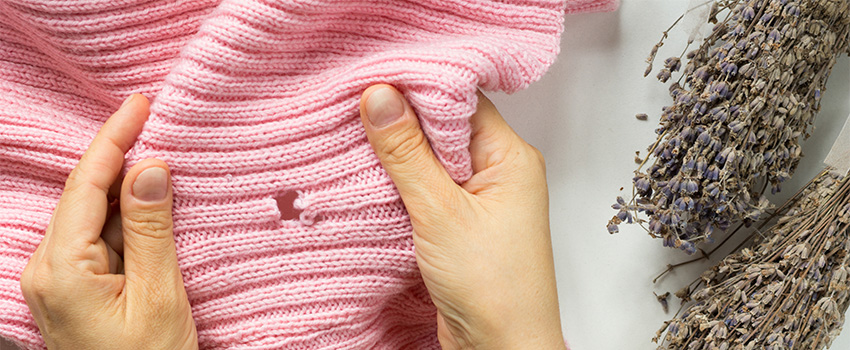We all know that moths can damage wool fabrics, but did you know that there are other insects that eat clothes made from cotton, linen, rayon, and even certain synthetics too?
Read on to learn some tips on how you can identify and control each bug from ruining your wardrobe.
Moths
There are millions of moths, but only two are often seen munching on your fabrics, especially wool pieces.
The webbing clothes moth is small, approximately half an inch in size. This pale gold-colored insect has no unusual markings and seldom leaves dark areas.
Do moths eat clothes? It is the larva that cuts holes in your clothes. It feeds for 5 weeks for up to 2 years depending on temperature, humidity, and food availability. It then spins a case and emerges as a full-grown moth two and a half weeks later. The breeding cycle starts again, and several generations can produce within a year.
A mothball that contains naphthalene is the best repellent against moths. You can scatter the balls in layers throughout the fabric. Be careful, though, because in moist conditions, naphthalene can cause discoloration of fabrics. Wrap it with paper to avoid direct contact with your clothes if necessary. It will not react with plastic, but it may corrode some metals.
If you need a less-toxic ingredient, look for moth crystals with Paradichlorobenzene (PDB). This should be used in sealed containers or closed rooms at high concentrations for 2 to 3 weeks. It can react with hard plastics, though, and melt storage boxes. Read the directions carefully before using this.
If you want natural moth repellent, grab some cedar and lavender!
Carpet Beetles
There are 3 species of carpet beetles. They all look similar except for their coloration patterns. Female carpet beetles can lay around a hundred soft, white eggs that will hatch in 8 to 15 days. They can hatch faster in warmer weather.
As soon as the egg hatches, the larvae will start to feed on fabrics. Aside from the carpets, they are also attracted to clothing fabrics like feathers, fur, mohair, and wool.
These fabric eating insects can be controlled via thorough cleaning. Use a vacuum to go over infested areas several times.
Wash soiled clothes repeatedly. In some cases, the use of insecticides may be necessary to stop the infestation. There are several active ingredients to choose from. You may buy bifenthrin, deltamethrin, permethrin, and more. Check if any of these products can be used on clothes. Read the label carefully! If not, you’ll have to move your clothes out of the closet during treatment.
Cockroaches
Aside from the threat of asthma and other diseases, roaches can also cause stains and holes in your clothes and other home fabrics! They are attracted to body fluid stains like sweat, food, drinks, and laundry starches. As they eat away at these ingredients, they can weaken or cut holes in cloth fibers.
Their feces will also stain clothes, which often requires the use of non-chlorine bleach or other stain removers to treat. Wash your clothes several times, if necessary.
Get rid of these fabric pests by cleaning and sanitizing the areas around your closet! Remove soiled clothes and vacuum eggs and droppings.
You can place insecticides in your closet to control the infestation. You should have one or more active ingredients such as chlorpyrifos, hydroprene gencor, pyrethrins, propoxur, or silica gel. Follow the directions carefully. Remove your clothes in the closet if necessary, to avoid contamination with the chemicals.
Silverfish
Silverfish is a wingless insect, approximately a quarter to half inch long. It has a carrot-shaped body and 5 legs. They often thrive in dark areas with an average temperature of 70 degrees F.
They like natural fibers like cotton, rayon, silk, or anything starched. Body soil and food spills also attract contamination. As they feed on these “foods,” they cut holes in your garments, normally following the outlines of a stain.
Wash soiled clothes properly and dry them well. Clean your closet before treating with an insecticide. Remove moisture and any food particles. Move your clothes as well to avoid contamination with the chemicals. You should be looking for the same active ingredients mentioned above.
Organic control can be done using silica gel after cleaning.
Cleaning the debris and vacuuming closets may already take most of your time. If you need someone to take care of your clothes to make sure they are free from any fabric eating insects, call Kelly’s Dry Cleaners, the best Pagosa Springs, CO dry cleaning service. We will be more than happy to help!



